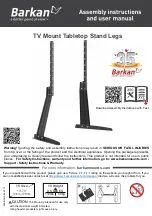
Service Modes, Error Codes, and Fault Finding
EN 21
LC7.5E LA
5.
5.4
Error Codes
5.4.1
Introduction
Error codes are required to indicate failures in the TV set. In
principle a unique error code is available for every:
•
Activated protection.
•
Failing I2C device.
•
General I2C error.
•
SDRAM failure.
The last five errors, stored in the NVM, are shown in the
Service menu’s. This is called the error buffer.
The error code buffer contains all errors detected since the last
time the buffer was erased. The buffer is written from left to
right. When an error occurs that is not yet in the error code
buffer, it is displayed at the left side and all other errors shift one
position to the right.
An error will be added to the buffer if this error differs from any
error in the buffer. The last found error is displayed on the left.
An error with a designated error code may never lead to a
deadlock situation. This means that it must always be
diagnosable (e.g. error buffer via OSD or blinking LED
procedure, ComPair to read from the NVM).
In case a failure identified by an error code automatically
results in other error codes (cause and effect), only the error
code of the MAIN failure is displayed.
Example: In case of a failure of the I2C bus (CAUSE), the error
code for a “General I2C failure” and “Protection errors” is
displayed. The error codes for the single devices (EFFECT) is
not displayed. All error codes are stored in the same error
buffer (TV’s NVM) except when the NVM itself is defective.
5.4.2
How to Read the Error Buffer
You can read the error buffer in 3 ways:
•
On screen via the SAM/SDM/CSM (if you have a picture).
Example:
–
ERROR: 0 0 0 0 0 : No errors detected
–
ERROR: 6 0 0 0 0 : Error code 6 is the last and only
detected error
–
ERROR: 9 6 0 0 0 : Error code 6 was detected first and
error code 9 is the last detected (newest) error
•
Via the blinking LED procedure (when you have no
picture). See “The Blinking LED Procedure”.
•
Via ComPair.
5.4.3
Error Codes
In case of non-intermittent faults, write down the errors present
in the error buffer and clear the error buffer before you begin
the repair. This ensures that old error codes are no longer
present.
If possible, check the entire contents of the error buffer. In
some situations, an error code is only the result of another error
and not the actual cause of the problem (for example, a fault in
the protection detection circuitry can also lead to a protection).
Table 5-2 Error code overview
Notes
1.
Some of the error codes reported are depending on the
option code configurations.
2.
This error means: no I2C device is responding to the
particular I2C bus. Possible causes: SCL/SDA shorted to
GND, SCL shorted to SDA, or SCL/SDA open (at uP pin).
The internal bus of the Trident platform should not cause
the entire system to halt as such an error can be reported.
5.4.4
How to Clear the Error Buffer
The error code buffer is cleared in the following cases:
•
By using the CLEAR command in the SAM menu:
–
To enter SAM, press the following key sequence on the
remote control transmitter: “062596” directly followed
by the OSD/i+ button (do not allow the display to time
out between entries while keying the sequence).
–
Make sure the menu item CLEAR is selected. Use the
MENU UP/DOWN buttons, if necessary.
–
Press the MENU RIGHT button to clear the error
buffer. The text on the right side of the “CLEAR” line will
change from “CLEAR?” to “CLEARED”
•
If the contents of the error buffer have not changed for 50
hours, the error buffer resets automatically.
Error
code
1)
Description
Item nr. Remarks
0
No error.
1
DC Protection of speakers.
2
+12V protection error.
12V missing or "low".
3
Reserved.
4
General I2C error.
note 2
5
Trident Video Processor
communication error.
7C01
When Trident IC is
defective, error 10 and 14
might also be reported.
Trident communicates via
parallel bus, not via the I2C
bus. The I2C bus of Trident
is only used in ComPair
mode.
6
I2C error while communicating
with the NVM.
7L23
The TV will not start-up due
to critical data not available
from the NVM, but the LED
will blink the error code.
7
I2C error while communicating
with the Tuner.
1101
8
I2C error while communicating
with the IF Demodulator.
7113
9
I2C error communicating with
the Sound Processor.
7411
10
SDRAM defective.
7D01
11
I2C error while communicating
with the HDMI IC.
7N01
12
I2C error while communicating
with the MOJO PNX8314.
7H03
if applicable
13
DVB HW communication
error.
7F01,
7K00,
7H03
if applicable
14
SDRAM defective.
7D02
15
I2C error while communicating
with the IBO COFDM channel
decoder.
7F01
16
I2C error while communicating
with the IBO NVM.
7H03
17
I2C error while communicating
with FPGA
7700 or
external
18
Reserved.
(iTV)
19
Reserved.
(1080p bolt-on module)
20
I2C error while communicating
with the IBO PCMCIA
controller.
7K00
21
I2C error while communicating
with the HDMI mux IC
7M07
22
I2C error while communicating
with the HDMI buffer in Side A/
V Panel
23
Reserved.
















































